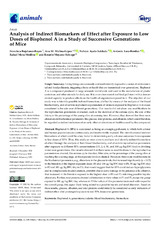Mostrar el registro sencillo del ítem
Analysis of Indirect Biomarkers of Effect after Exposure to Low Doses of Bisphenol A in a Study of Successive Generations of Mice
| dc.contributor.author | Bujalance Reyes, Francisca | |
| dc.contributor.author | Molina López, Ana María | |
| dc.contributor.author | Ayala Soldado, Nahúm | |
| dc.contributor.author | Lora Benítez, Antonio | |
| dc.contributor.author | Mora Medina, Rafael | |
| dc.contributor.author | Moyano Salvago, M. Rosario | |
| dc.date.accessioned | 2022-01-26T12:11:53Z | |
| dc.date.available | 2022-01-26T12:11:53Z | |
| dc.date.issued | 2022 | |
| dc.identifier.uri | http://hdl.handle.net/10396/22392 | |
| dc.description.abstract | Bisphenol A (BPA) is considered as being an emerging pollutant, to which both animal and human populations are continuously and inadvertently exposed. The identification of indirect biomarkers of effect could be a key factor in determining early adverse outcomes from exposure to low doses of BPA. Thus, this study on mice aims to evaluate and identify indirect biomarkers of effect through the analysis of their blood biochemistry, and of certain reproduction parameters after exposure to different BPA concentrations (0.5, 2, 4, 50, and 100 µg/kg BW/day) in drinking water over generations. Our results showed that there were no modifications in the reproductive parameters evaluated, like estrous cycle duration, litter size, or the percentage of the young alive at reaching the weaning stage, at the exposure levels evaluated. However, there were modifications in the biochemical parameters, e.g., alterations in the glucose levels, that increased significantly (p < 0.05) in the breeders at the higher exposure doses (50 and 100 µg/kg BW/day in F1; 50 µg/kg BW/day in F2 and 100 µg/kg BW/day in F3), that would suggest that the BPA could induce hyperglycemia and its complications in adult animals, probably due to some damage in the pancreas cells; albumin, that increased in the breeders exposed to the highest dose in F1 and F3, inferring possible hepatic alterations. Further, total proteins showed a diminution in their values in F1 and F2, except the group exposed to 100 µg/kg BW/day, whereas in F3 the values of this parameter increased with respect to the control group, this aspect likely being related to a possible hepatic and renal alteration. Based on these results, glucose, albumin, and total proteins could initially be considered as early indicators of indirect effect after prolonged exposure to low BPA doses over generations. | es_ES |
| dc.format.mimetype | application/pdf | es_ES |
| dc.language.iso | eng | es_ES |
| dc.publisher | MDPI | es_ES |
| dc.rights | https://creativecommons.org/licenses/by/4.0/ | es_ES |
| dc.source | Animals 12(3), 300 (2022) | es_ES |
| dc.subject | Bisphenol A | es_ES |
| dc.subject | Generations | es_ES |
| dc.subject | Rodents | es_ES |
| dc.subject | Blood biochemistry | es_ES |
| dc.subject | Biomarkers | es_ES |
| dc.title | Analysis of Indirect Biomarkers of Effect after Exposure to Low Doses of Bisphenol A in a Study of Successive Generations of Mice | es_ES |
| dc.type | info:eu-repo/semantics/article | es_ES |
| dc.relation.publisherversion | https://doi.org/10.3390/ani12030300 | es_ES |
| dc.relation.projectID | Junta de Andalucía. P09-AGR-5143 | es_ES |
| dc.rights.accessRights | info:eu-repo/semantics/openAccess | es_ES |

